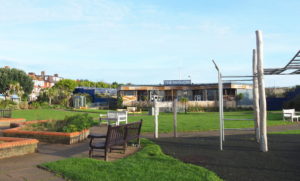Eastbourne is unusual as it still has the remains of a Martello tower and a massive fort, the Redoubt built in response to a possible invasion by Napoleon.
The Redoubt is one of three massive fortresses built in the early 1800s along the south coast, along with 74 smaller Martello towers, in response to Napoleon’s expected invasion of England.
It is a large circular structure, measuring about 224 ‘ in diameter and is surrounded by a deep dry moat, with a drawbridge.
The moat contains five small structures, or caponiers, which allowed defending soldiers to fire on attackers who entered the moat. On the outside of the moat is a grassy glacis or earth bank designed to absorb the shock of enemy bombardment.
There were 11 gun emplacements around the top of the wall with casements beneath them. These provided accommodation as well as stores and a cook house.
The drawbridge led directly to the gun platform with steps down to the central parade ground.
The Redoubt could accommodate up to 350 soldiers. Living conditions were basic and there was no fresh water supply. There were four underground tanks but they could be contaminated with salt water during very high tides. There was some accommodation in the casements, otherwise soldiers lived under canvas on the parade ground.
Nelson’s victory over Napoleon at the Battle of Trafalgar in 1805 ended any risk that Britain would be invaded. The guns were only fired once at a passing French warship in 1812 and missed.
By the 1830s, the garrison consisted of only seven gunners and a gate keeper, along with their families. Its main role was as a barracks with troops being stationed there for a few weeks while undergoing training.
By 1859 advances in warfare and artillery meant that a British Government report found that the Martello Towers and Redoubts were ‘not an important element of security against attack’.
During the First World War, the Redoubt was the headquarters of the military police and acted as a temporary goal. During the Second World War it was used by the army for storage. Anti-aircraft guns were mounted on the gun platforms and it was used by Canadian troops in preparation for the D-Day landings.
The moat and glacis on the seaward side were removed when the construction of the sea wall and promenade in 1890, exposing the outer wall of the Redoubt. This area is now the site of a wooden sculpture, Azimuth, using reclaimed timbers from sea defences. The information panel describes it as either an image of long lost shipwrecks or the ribs of a mythical sea creature
The area to the south west of the Redoubt has been landscaped with gardens and the Pavilion Cafe.
The Redoubt was closed for all of 2021, following the Covid lockdowns. It houses a small cinema as well as a museum . Even so, it is still worth going to look at the outside of this remarkable building. The gun outside is similar to those that would have been used in the early C19th.








